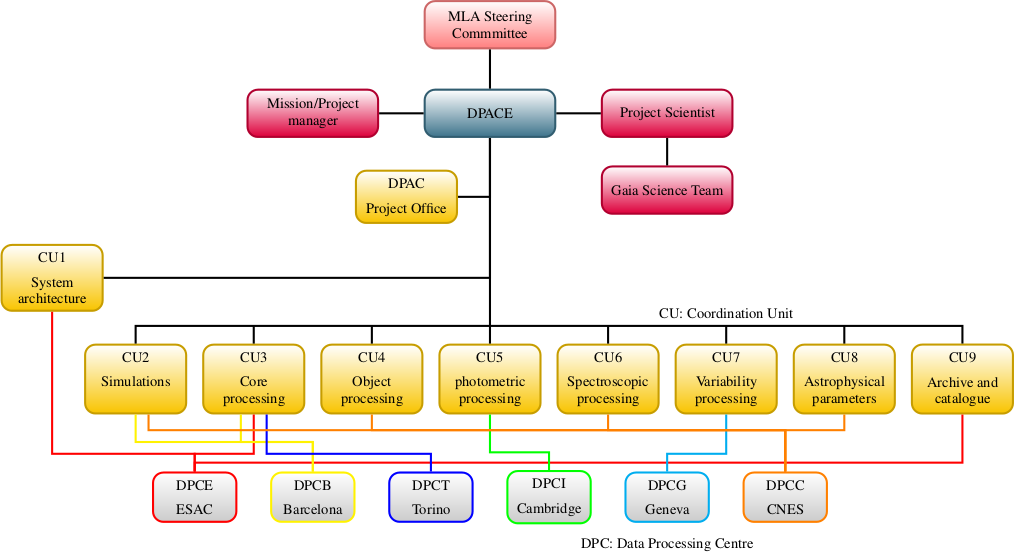1.2.2 Organigramme and funding
Figure 1.10 shows an organigramme of DPAC, with the major elements discussed in the following sections. The DPAC is funded through national funding agencies of the participating ESA member states. These funding agencies, including ESA, have signed a multi-lateral agreement (MLA) which commits all parties to fund DPAC efforts up to the end of 2022.

Executive
DPAC is managed by an executive body – the DPAC executive, DPACE – consisting of 12 members. See https://www.cosmos.esa.int/web/gaia/gaia-dpac-executive for the composition of DPACE. The DPACE regularly reports to the MLA steering committee (SC) which consists of representatives of ESA and the major partner funding agencies (Section 1.2.2).
Project office
The DPAC executive (Section 1.2.2) is supported in its tasks by the DPAC project office (PO) which takes care of the day-to-day guidance and coordination of the operational activities. See Gaia Collaboration et al. (2016b), Gracia-Abril et al. (2019), and https://www.cosmos.esa.int/web/gaia/project-office for more details.
Coordination units
DPAC is composed of nine coordination units (the CUs), each in charge of a specific aspect of the data processing, with clearly defined responsibilities and interfaces. Each CU is composed of several dozen members, spread around various (academic) institutes in various, mostly European countries (see https://www.cosmos.esa.int/web/gaia/dpac/institutes). Activities of DPAC members at institutes as well as institute involvement vary over the years, as reflected in the list of affiliations in the release papers of the various releases (e.g., Gaia Collaboration et al. 2016a; Gaia Collaboration et al. 2018a). The details of the various DPAC data processing systems are provided in Gaia Collaboration et al. (2016b). In Table 1.7, the DPAC coordination units are listed by number, together with the data processing (sub-)systems and specific tasks that the CU in question is responsible for. Although this is not of direct interest to the reader of this documentation, the CUs are sometimes referred to in the text and this table provides the means to understand the context of such references.
| CU | Data processing (sub-)systems and specific tasks |
| CU1 | System architecture (Section 1.2.3), common tools (Section 1.2.3), main database (MDB; Section 1.2.3), catalogue integration |
| CU2 | Simulations (Section 1.2.3 and Chapter 2) |
| CU3 | Initial data treatment (IDT; Section 3.4.2) and first look (FL; Section 3.5.2), astrometric verification unit (AVU; Section 3.5.1), astrometric global iterative solution (AGIS; Section 4.4.2), global sphere reconstruction (GSR; Section 3.5.1), intermediate data update (IDU; Section 3.4.2), relativistic astrometric models, auxiliary science data / observations (e.g., spectro-photometric standard stars, SPSSs; Section 5.6) |
| CU4 | Solar-system science alerts, non-single-star (NSS) treatment (Chapter 7), Solar-system-object (SSO) treatment (Chapter 8), extended-object (EO) analysis (Chapter 9), extra-galactic objects (Chapter 12) |
| CU5 | Photometric pipeline (PhotPipe; Chapter 5), source-environment analysis (SEA), Gaia photometric science alerts (GSA; Section 5.7), LSF/PSF calibration (CalTools; Section 3.3.5) |
| CU6 | RVS daily processing and RVS pipeline (Chapter 6) |
| CU7 | Variable-star processing and analysis (Chapter 10) |
| CU8 | Astrophysical-parameter inference (Apsis; Chapter 11) |
| CU9 | Data validation and catalogue publication (Chapter 14) |
Data processing centres
The actual processing of the Gaia data takes place at six data-processing centres (DPCs) in Europe, located at ESAC near Madrid (DPCE, Section 1.3.5), the University of Barcelona (DPCB, Section 1.3.5), CNES in Toulouse (DPCC, Section 1.3.5), the Institute of Astronomy (IoA) in Cambridge (DPCI, Section 1.3.5), the University of Geneva (DPCG, Section 1.3.5), and the University of Turin (DPCT, Section 1.3.5). More details are provided in Gaia Collaboration et al. (2016b).
Payload experts
A payload experts (PE) group is dedicated to (discussing the findings of the) monitoring of the health of the Gaia payload, which is routinely done by First Look (Section 3.5.2), and is formed primarily by DPAC members who are directly involved with processing the Gaia ‘raw’ data stream on a daily or semi-daily basis (Section 1.2.3), as well as members of the project office (Section 1.2.2), Gaia’s mission manager and project scientist (see Section 1.1.5 and https://www.cosmos.esa.int/web/gaia/esa-team), and members of ESA’s Science Operations Centre (Section 1.1.5). During Gaia’s Commissioning phase, the payload experts played a critical and intensive role in verifying the operational health of the payload, assisting in the adjustment of payload calibration and configuration parameters (such as the spin rate and focussing), and in the early identification of various instrument anomalies and investigation into their root causes, including a variable, and higher-than-expected, background and the periodic variation of Gaia’s basic angle. During the routine science operations phase, the payload experts continue to monitor the instrument status (such as optical throughput and quality) and of various, known instrument issues that (may) impact the quality of the science data. The payload experts propose adjustments in the payload operating parameters as well as signal the need for decontamination and re-focussing campaigns (Section 1.3.3). The description of the current instrument status in Section 1.3.3 gives some concrete examples of their efforts.